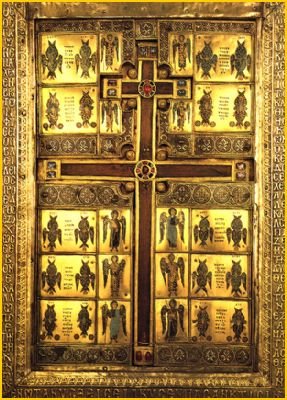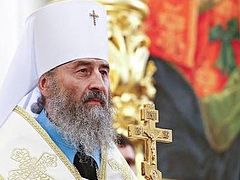
On August 1/12, the Dormition fast begins with the feast of the Procession of the Honorable Wood of the Holy and Life-Giving Cross, commemorating a tradition that began in Constantinople. How did the True Cross come to Byzantium, and what did this mean for that great Christian city? This excerpt from the book Sacred Relics and Imperial Ceremonies at the Great Palace of Constantinople by Holger A. Klein describes the history surrounding the Holy Cross in the Byzantine Empire.
The Persian invasion of Syria-Palestine in 614 and the Arab conquest of Jerusalem in 637/38 resulted in a number of important relic translations during the reign of Emperor Herakleios (610-641) and changed Constantinople’s status as a repository of sacred relics for centuries. As suggested by the Chronicon Paschale, the relic of the Holy Lance, Sponge, and the True Cross from Jerusalem were recovered from the Persians during the fall of 629, transferred to the capital, and exhibited for public veneration in the church of Hagia Sophia for several days. While Emperor Herakleios, according to some sources, triumphantly returned the relic of the True Cross from Constantinople to Jerusalem and exalted it in the Church of the Holy Sepulcher on 21 March of the following year, the unexpected loss of the Holy City to the Arabs soon necessitated the relic’s transfer back into the capital, where it was now safeguarded by the emperor and kept inside the confines of the imperial palace.
The forced relocation of the "larger part" of the relic of the True Cross from Jerusalem to Constantinople and its presumed deposition in the imperial palace not only ensured the Empire’s safety and prosperity for the future, it also re-affirmed the emperor’s role as the guardian and protector of Christianity’s most sacred treasure. While a smaller portion of the relic, associated with Constantine the Great and set in a bejeweled processional Cross, had already been used in imperial processions in the beginning of the sixth century, and is known to have preceded the imperial army on military campaigns during the reign of Emperor Maurice, it was the alleged return of the True Cross from Jerusalem that effectively transformed Constantinople into a "New Jerusalem" and the imperial palace into a locus sanctus at the heart of the Empire. The possession of the True Cross not only reinforced the emperor’s divine mandate but also rendered him the most important distributor of relics of the True Cross in the Christian world, a position future emperors would eagerly exploit in building political alliances with Christian rulers and potentates in Western Europe.
Where the relic of the True Cross from Jerusalem was originally kept cannot be determined with certainty. In the second half of the seventh century, when Bishop Arkulf visited Constantinople on his way back from the Holy Land, a portion of the relic was, at least for the time of its public veneration during Holy Week, kept inside Hagia Sophia in a "very large and beautiful chest [...] to the north of the interior of the building." Arkulf’s testimony has often been considered as an indication that the main relic of the True Cross had, by the seventh century, been entrusted to the care of the Patriarch. Judging from later accounts, however, it is more likely that the relic of the True Cross from Jerusalem and the so-called "Cross of Constantine," first mentioned by Theodore Anagnostes, were both safeguarded inside the imperial palace, presumably in the skeuophylakion, and removed only temporarily for specific liturgical and ceremonial functions. As recorded in Constantine VII Porphyrogennetos’ Book of Ceremonies [10th cent.], important relics of the True Cross were still kept in the skeuophylakion of the imperial palace during the tenth century and taken out on specific feasts and occasions. One such feast was a six-day-long festival celebrated in mid-Lent that included a public display and veneration of the relic of the True Cross inside Hagia Sophia and a related imperial ceremony performed in the palace.

According to the Book of Ceremonies, celebrations started on the third Sunday of Lent in the skeuophylakion of the imperial palace. Between the third and sixth ode of Orthros [Matins], the "three glorious and life-giving Crosses," were removed from the treasury, embalmed by the protopapas, and taken to the Nea Ekklesia, to be venerated by all. After Orthros was concluded, the Crosses were taken to the gallery of the church, where the clergies of the Nea and the imperial palace jointly intoned the troparia of the Crucifixion. At this time, the emperor and his co-emperors were given the opportunity to venerate and kiss the precious and life-giving relics. Then, the three Crosses were separated from each other. Accompanied by the clergy of the Nea, a deacon carried one of them back down to the main level of the church to be displayed for further veneration. The second Cross was taken over by the papias of the Great Palace, who, accompanied by the palace clergy, the protopapas of the church of St. Stephen, and the diaitarioi of the palace, carried it in festive procession through the Heliakon [of the Chrysotriklinos] and from the Chrysotriklinos into the Lausiakos, where it was displayed for the veneration by members of the senate. The Cross was then taken to the Church of the Protomartyr Stephen in the Daphne palace, where it remained over night. On the following day, the papias took the relic to Hagia Sophia, where it was displayed for veneration by the faithful during the rest of the week. The third Cross never left the gallery of the Nea. After none on Friday, when public venerations had ended at Hagia Sophia, the papias and the clergy of the Nea brought the respective Crosses back into the palace. Finally, between the third and sixth ode of Orthros on Sunday, the protopapas and the skeuophylax returned all Crosses to the skeuophylakion.
What is striking about this description is not only the fact that, by the tenth century, three Crosses of the glorious and life-giving Wood, were kept in the skeuophylakion of the imperial palace, but also that these relics were employed in a complex ceremony that involved their display in three distinct locations within the imperial palace—the Nea Ekklesia, the Lausiakos, and the Church of St. Stephen—as well as in the church of Hagia Sophia.
Another, closely related ceremony involving the True Cross is described in the Book of Ceremonies for the week before and the two weeks following August 1. Once again, the ceremony started between the third and sixth ode of Orthros in the skeuophylakion of the palace. After the relic was embalmed, it was taken to an unspecified church within the imperial palace, where it was displayed for veneration by the emperors. The relic was then taken to the Lausiakos, where it was set up to be venerated by the members of the senate. Afterwards, the Cross was taken to the church of St. Stephen, from where it was carried through each of the quarters of the capital to "cleanse and sanctify all places and houses of the God-guarded and imperial city; and not only the buildings, but also the walls of the city and its suburbs." When the relic returned from its journey on August 13, it was first brought to the Chrysotriklinos and placed on the imperial throne. Then, the papias, accompanied by the protopapas and the clergy, took the relic through the rooms of the imperial palace to cleanse and sanctify them as well. For a short while thereafter, the relic was kept in the oratory of St. Theodore, before the papias carried it back to the Church of the Virgin of the Pharos after Vespers. Here, the relic was received by the skeuophylax of the palace and returned to the treasury between the third and sixth ode of Orthros.



